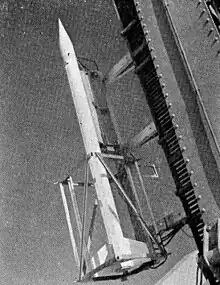
.jpg.webp)
LEX (french: Lithergol EXpérimentale) was a French experimental hybrid-propellant sounding rocket, developed by ONERA.[1][2][3][4] It had the objective of testing a lithergol fueled rocket engine (an hybrid mixture of solid and liquid propellants - Nylon-metatoluene-amine as fuel and mixture of nitric acid and nitrous tetroxide as oxidizer).[1] It was the first rocket in history to use this technology, flying 8 times between 1964 and 1967.[5][6][1]
The rocket had a single stage with a thrust of 10.00 kN (MT.27 hybrid rocket motor), a gross mass of 100 kg, a height of 3.40 m, and a diameter of 0.16 m, reaching an apogee of 130 km.[6][1]
Launches
All LEX launches were carried out from CERES Ile du Levant.[1]
The first LEX-01 launch on 25 April 1964 was a partial success, with the payload consisting of a telemetry transmitter.[5][6]
Three LEX-02 rockets were fired on 1 June 1965. One of these rockets, with an initial mass of 78 kg, reached an altitude of 68 km.[5][6]
Four LEX-02-B launches occurred on 1 November 1967. Two were intended as technological tests and two others as actual payload launches.[5][6] These carried the SECT Meteo meteorological payloads, reaching an altitude of more than 100 km, with a parachute ensuring a correct descent for 31 minutes allowing wind measurements over a wide range of altitudes.[5][1]
| Flight no. | Version | Launch date (UTC) | Payload(s) | Apogee | Notes |
|---|---|---|---|---|---|
| 1 | LEX-01 | 04/25/1964 | Telemetry transmitter | 1 km | First flight of LEX (partial failure due to residues in the engine) |
| 2 | LEX-02 | 06/01/1965 | Telemetry transmitter | 68 km | First flight of LEX-02 |
| 3 | LEX-02 | 06/01/1965 | Telemetry transmitter | 60 km | |
| 4 | LEX-02 | 06/01/1965 | Telemetry transmitter | 60 km | Last flight of LEX-02 |
| 5 | LEX-02B | 01/11/1967 | Telemetry transmitter | 101 km | First flight of LEX-02B |
| 6 | LEX-02B | 01/11/1967 | SECT Meteo | 80 km | |
| 7 | LEX-02B | 01/11/1967 | SECT Meteo | 115 km | |
| 8 | LEX-02B | 01/11/1967 | SECT Meteo | 115 km | LEX's last flight |
See also
References
- 1 2 3 4 5 6 7 Gunter D., Krebs (2024). "LEX". Gunter's Space Page. Retrieved 2024-01-03.
- ↑ Lestrade; Messineo; Hijlkema; Prévot; Casalis; Anthoine (June 2016). "Challenges in Combustion for Aerospace Propulsion - Hybrid Chemical Engines: Recent Advances from Sounding Rocket Propulsion and Vision for Spacecraft Propulsion" (PDF). Journal Aerospace Lab (11): 6.
- ↑ Surmacz, Paweł & Rarata, Grzegorz. (2009). Hybrid Rocket Propulsion Development and Application. Progress in Astronautics.
- ↑ Okninski, Adam; Kopacz, Wioleta; Kaniewski, Damian; Sobczak, Kamil (2021-12-01). "Hybrid rocket propulsion technology for space transportation revisited - propellant solutions and challenges". FirePhysChem. Progress in Hybrid Rocket Propulsion. 1 (4): 260–271. Bibcode:2021FPhCh...1..260O. doi:10.1016/j.fpc.2021.11.015. ISSN 2667-1344.
- 1 2 3 4 5 6 "La fusée Lex". Eurospace. 1999.
- 1 2 3 4 5 6 Wade, Mark (2019). "Lex". Encyclopedia Astronautica. Retrieved 2024-01-03.